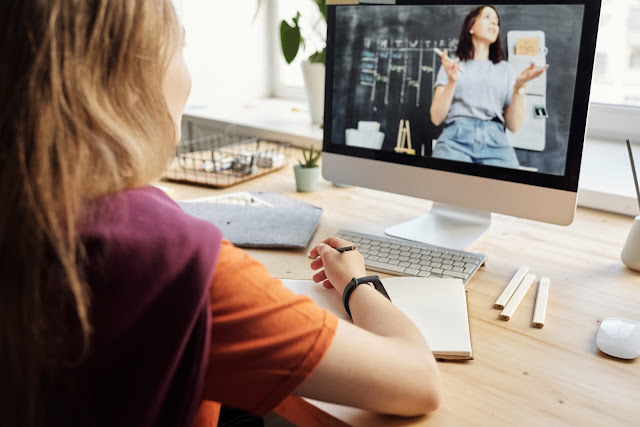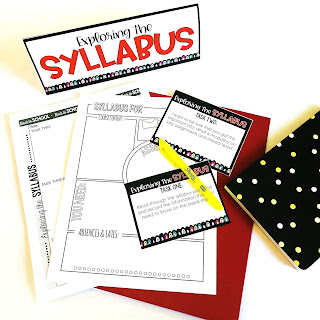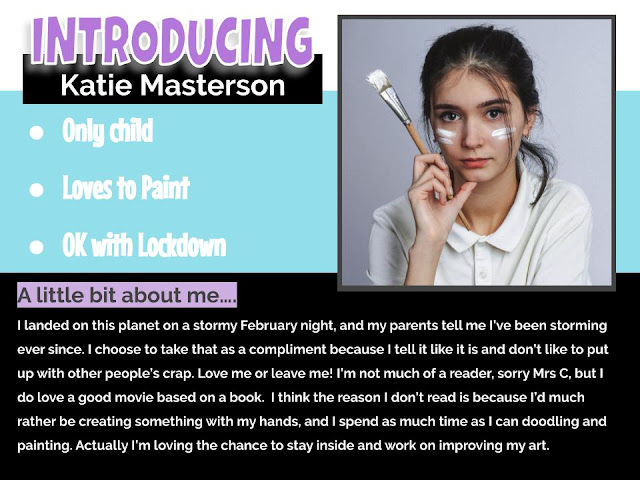We might just do it all again. I’ve been struggling with this concept while I wander through my distance learning journey - and as much as I hope that it doesn’t happen, I am actively preparing for the possibility of some distance learning in the fall.
I’m not just talking about creating digital lesson plans. Those are important, but what I really need to work on are the skills students will need to be successful if they are learning from home again.
So stay with me as I share some ideas and lessons that you may be able to adapt for your situation:
Creating a Climate for Distance Learning
I’m not just talking about creating digital lesson plans. Those are important, but what I really need to work on are the skills students will need to be successful if they are learning from home again.
So stay with me as I share some ideas and lessons that you may be able to adapt for your situation:
Creating a Climate for Distance Learning
During the first days and weeks of my classes, I always put a lot of time and energy into building relationships with my students. I also work hard on creating a classroom climate where they feel safe, accepted and ready to learn. For me, this is the foundation on which everything else we do will be built. Without it, it’s much harder to make the learning magic happen.
However, classroom community is the hardest thing to maintain when your kids aren't in front of you. Creating it if we don't start in the classroom will be even harder.
Scenario One: starting in school
However, classroom community is the hardest thing to maintain when your kids aren't in front of you. Creating it if we don't start in the classroom will be even harder.
Scenario One: starting in school
Let’s start with scenario one: we assemble face-to-face in September. If this happens, even in a modified version, I will do what I always do - just more of it - so we can quickly get to know each other well. Then, if we are sent home again, we will have that foundation to build on.
How do I do this? Well, I have my usual teacher tricks of standing at my door and dropping by desks to chat with my new students so I can start building my relationship with them. And, during the first day or two, I use my Getting to Know You Stations (which I will covert for Google Drive over the summer, just in case). These stations offer students the opportunity to get to know me and my expectations, while they introduce themselves to me and collaborate with their new classmates.
I also have a Getting to Know You Freebie that you can grab here. It takes less time than the stations but is a great first day activity that gets students moving and talking to each other.
Scenario Two: starting the year online
This scenario is not very appealing. But it may happen, and I don’t want to be scrambling in August to figure out how to digitize the process of creating a classroom climate. I'm going to need that time on the beach after this year...I also have a Getting to Know You Freebie that you can grab here. It takes less time than the stations but is a great first day activity that gets students moving and talking to each other.
Scenario Two: starting the year online
So in case we aren't together in September, I've created a Getting-to-Know-You exercise that my students can use at home.
For this activity, students will create a slide that they will use to introduce themselves to the class. Then, after they have all been submitted, I'll share them with everyone, and they will do a getting-to-know-you scavenger hunt so they can learn about the classmates they haven't met face-to-face yet. Students will have the option of using a photo of themselves or an object or quote that represents them. They can also record their introduction if they prefer.
This activity will not be the same as our face-to-face ones, but I think it's an alternative that the kids will enjoy. You can grab a free template here. If you would like a more detailed one with more options for students, click here.
Teaching Students to Be Independent Learners:
This activity will not be the same as our face-to-face ones, but I think it's an alternative that the kids will enjoy. You can grab a free template here. If you would like a more detailed one with more options for students, click here.
Teaching Students to Be Independent Learners:
If we start school in the building, I will be front loading all of the skills my students will need to be successful in the course if we get sent home again. I always begin the year by scaffolding skills, but in September, I will know that I can’t spread this out like I normally do. I need to get them ready as quickly as I can.
We have used Google Classroom for some time, so our kids know the ins and outs of how to use it. However, there are other skills that they will need so they can work independently:
1. Learning to ask good questions
Knowing what questions to ask is usually more important than knowing the right answer, so when school starts, I will be spending a lot of time on the art of good questioning. I find that the best way to do this is through modelling my own process, and during the first days and weeks of school I will be focusing on building in opportunities to do this.
For example, on one of the first days of class, I give my kids a copy of Matthew Foley's What You Will Need in Class Today. It's a spoken word poem that urges students to be present in class with a "fire in [their] belly." I want my kids to get that message, but I also use the poem to show them how I use questioning as I close read to to figure out the author's message.
You can grab my lesson here. (Be sure to check out the presentation notes for each slide if you want to use this).
2. Focusing on the process of learning:
This goes hand in hand with teaching my kids to question - I need to show them how to find the answers to those questions. Learning is a process and takes some work - answers don't just fall from the sky. So, we focus a lot on processes in Room 213, and we will spend a lot of time on that in September if we meet face-to-face. That way, if we move to distance learning again, the students will have those skills. This will begin with an emphasis on how to figure things out for themselves. If a kid asks how to do something that I know they have a handout for, instead of answering them, I'll ask them if they've looked in their binder yet. If they ask what a word means, I'll tell them they can use their phone to look it up. I want them to know that they have the skills to find things out themselves.
I will also model and practice the skills for the following because they are ones that will be necessary for learning at home. You can click on the links to read posts about how I teach these skills in class. My hope is that I can get as many of these lessons in before flu season sends us home again.
- Close Reading and Responding to Text
- Critical Thinking
- Building a Habit of Revision
- The Writing Process
- Literary Analysis
Plan Assignments That Are Best for Distance Learning
One thing we've all learned this spring is that it's not always easy to engage and teach kids from our couches. So, I'm thinking it'd be wise to plan for assignments that are not only engaging, but also easy to do from home.
The worst case scenario is that we are teaching remotely for a semester or the year...If that happens, I’m just going to have to suck it up, embrace it, and roll out the whole course digitally. However, I am hopeful that this may only happen for some months of the year (or not at all!). For that reason, I am “setting aside” some assignments that I know will be best to keep kids engaged.
Engaging Informational Texts:
My students tend to find short nonfiction a little more interesting than short stories and poetry, especially when it's an interesting or controversial topic. Nonfiction is also pretty accessible to them online, so I have a pile of lessons ready to go should I need them.
Choice Boards:
I have had a lot of success with these during this round of distance learning. They are designed so kids can easily do them on their own, and they can choose topics that they find interesting. You can grab two different free ones, or get the whole bundle here.
Multi-genre projects: The Multi-genre project is a staple in my classroom, and you can read all about my love for it here. Of course, I hope to conclude next semester with the MGP; however, I plan to have my students practice the process if we have a Covid-induced hiatus in the fall. This is because the multi-genre project is perfect for them to explore things that they are interested in, while practicing important ELA skills. Wow. There's just so much swirling in my head as I try to process this. I really hope I was able to present it in a way that made sense. You can be sure that I will be blogging about my plans and sharing ideas on my Instagram account during the summer - so stay tuned! We'd love to hear about your preparations for the fall as well, so feel free to leave a comment.> If you would like some help learning to use Google Forms, The Daring English Teacher has some tips for you here. She also has a great resource for teaching kids email etiquette - another skill they will need for remote learning.Take care!
The worst case scenario is that we are teaching remotely for a semester or the year...If that happens, I’m just going to have to suck it up, embrace it, and roll out the whole course digitally. However, I am hopeful that this may only happen for some months of the year (or not at all!). For that reason, I am “setting aside” some assignments that I know will be best to keep kids engaged.
Engaging Informational Texts:
My students tend to find short nonfiction a little more interesting than short stories and poetry, especially when it's an interesting or controversial topic. Nonfiction is also pretty accessible to them online, so I have a pile of lessons ready to go should I need them.
Choice Boards:
I have had a lot of success with these during this round of distance learning. They are designed so kids can easily do them on their own, and they can choose topics that they find interesting. You can grab two different free ones, or get the whole bundle here.
Multi-genre projects: The Multi-genre project is a staple in my classroom, and you can read all about my love for it here. Of course, I hope to conclude next semester with the MGP; however, I plan to have my students practice the process if we have a Covid-induced hiatus in the fall. This is because the multi-genre project is perfect for them to explore things that they are interested in, while practicing important ELA skills. Wow. There's just so much swirling in my head as I try to process this. I really hope I was able to present it in a way that made sense. You can be sure that I will be blogging about my plans and sharing ideas on my Instagram account during the summer - so stay tuned! We'd love to hear about your preparations for the fall as well, so feel free to leave a comment.> If you would like some help learning to use Google Forms, The Daring English Teacher has some tips for you here. She also has a great resource for teaching kids email etiquette - another skill they will need for remote learning.Take care!







